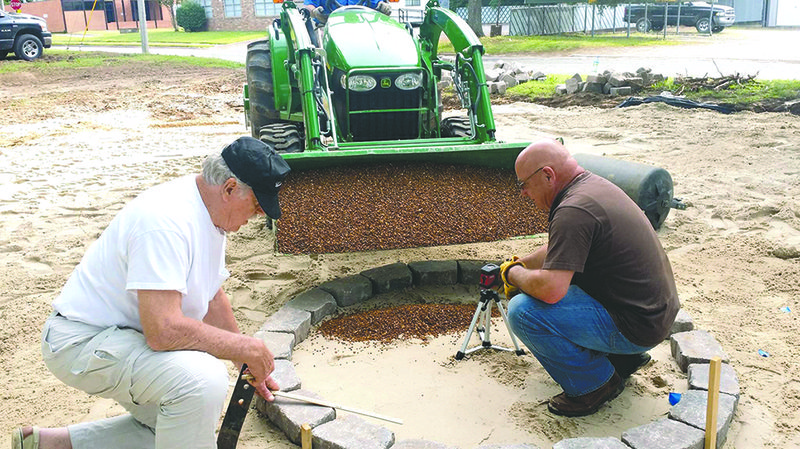SEARCY — With the dedication of the labyrinth in Presbyterian Park in Searcy on May 31, there are now 26 labyrinths within a 100-mile radius of the city. Other labyrinths located in or near the Three Rivers Edition coverage area are in Heber Springs, Conway, Mountain View, Little Rock, North Little Rock, Clinton and Russellville.
During the construction phase of Searcy’s labyrinth, many questions were asked, not only by members of the church, but also by people throughout the city who became curious about what those people, and their equipment, were doing in Presbyterian Park.
Many workers spent long hours providing equipment such as tractors and blades, trailers, shovels, rakes and hoes, in addition to their healthy backs.
The area was leveled before a vapor barrier was put down and the design work actually began. Between the stones lining the path, sand was leveled and topped with pea gravel.
Men and women of the church were reluctant to provide names of volunteers, for fear they would leave someone out, but more than one said the following should be recognized for contributing to the construction process: the Rev. Kade Curry, pastor of First Presbyterian Church, and Ty Hendrix, a church member and a history teacher at Ahlf Junior High School.
Among others often seen working at the site were Tommy Wood, Bill Holden, Mike Szabo, Duke Webb, Sonny Ekdahl, Jeremy Hightower, Mark Pate and Bill Bowman. Not to be outdone, several women, including Nichole Cook, Sue Ekdahl and Pat Collier, were also found busy on the scene at times.
During the project’s planning and construction phase, people, including some members of the church, began to ask, “What’s a labyrinth?”
Research identifies a labyrinth as an ancient symbol that relates to wholeness. It
combines the imagery of a circle and spirals into a meandering, yet purposeful, path. Actually, it represents a journey to a person’s center and back again into the world. More information in the form of a pamphlet provided by the church has been placed near the entrance to the labyrinth. Visitors are invited to take a pamphlet and read it as they start their walk, and to do the following:
Enter into Labyrinth time.
Ponder on your life’s design.
Spiral down into the core,
Determine what your life is for.
Stand here now in sacred space,
God is Spirit in this place.
Spiral out back to your world,
Be not seduced by maddening swirl.
Not many may find time to “ponder” on life’s design, thinking life is too busy for “pondering,” for which synonyms from a thesaurus include thoughtful, meditative, thinking, brooding, contemplating and preoccupied.
At least, many may think their lives are too busy for pondering, but if they read the Scriptures printed on the back of the pamphlet, they might be tempted to
slow down, Curry said.
There is a Scripture for the “Inward Journey,” another for the “Center Space” and, lastly, one for the “Outward Way.”
“We want everyone to know there is no right or wrong way to walk a labyrinth, and that more than one person can be on the path at a time,” Curry said.
“At the entrance, quiet your mind and open your heart, for a labyrinth walk is sometimes referred to as body prayer or walking meditation,” he said.
In the pamphlet, readers will also find information about the history of labyrinths.
The earliest use of a labyrinth by Christians is thought to be evident the one constructed of stone in the floor of the Chartres Cathedral near Paris, France, around 1200 A.D. The faithful could make a pilgrimage to the cathedral and walk the labyrinth as a symbol of a journey to the Holy Land.
The Searcy labyrinth project has been funded mostly by a $3,000 grant from the Synod of The Sun, which serves Presbyterian churches in Texas, Oklahoma, Louisiana and Arkansas. Hendrix said he and Curry worked together on the grant and are considering applying for a second grant to help with landscaping and, perhaps, to build a memorial garden. But they want everyone to know that the labyrinth in Presbyterian Park, next to the church at 400 W. Arch St. in Searcy, is officially “open and ready for your walk.”
At the labyrinth’s dedication,
Curry said the following:
“We dedicate this sacred space for the spiritual growth and nourishment for all who seek God here, to our church and its members, to our community and our neighbors, and to any and all who seek God through Jesus Christ. Let all who walk here be
reminded that life is a sacred journey.
“It is about change, growth, discovery, movement, transformation, continuously expanding your vision of what is possible, stretching your soul, learning to see clearly and deeply, listening to your intuition, taking courageous challenges at every step along the way.
“We are on the path … exactly where we are meant to be right now. … And from here, we can only go forward, shaping our life story into a magnificent tale of triumph, of healing, of courage, of beauty, of wisdom, of power, of dignity and of love.”
